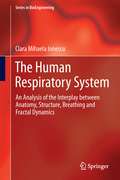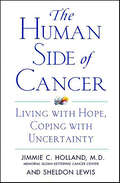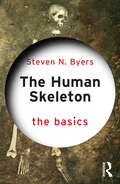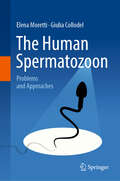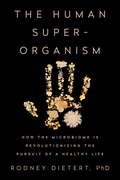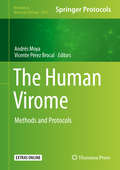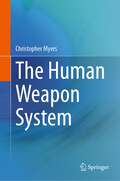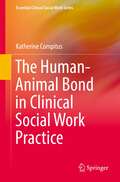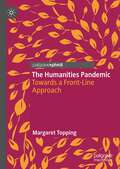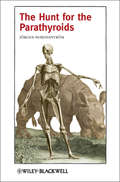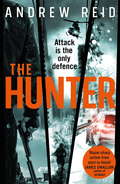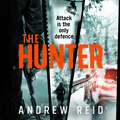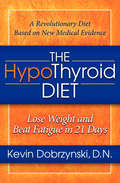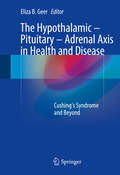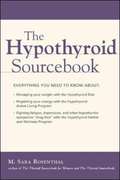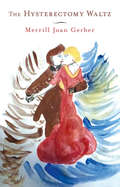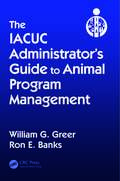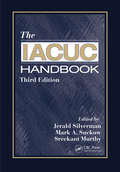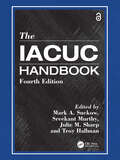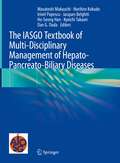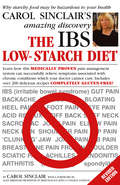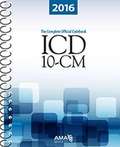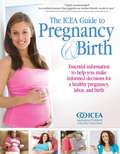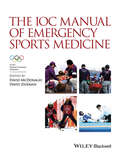- Table View
- List View
The Human Respiratory System: An Analysis of the Interplay between Anatomical Structure and Breathing Dynamics
by Clara Mihaela IonescuThe Human Respiratory System combines emerging ideas from biology and mathematics to show the reader how to produce models for the development of biomedical engineering applications associated with the lungs and airways. Mathematically mature but in its infancy as far as engineering uses are concerned, fractional calculus is the basis of the methods chosen for system analysis and modelling. This reflects two decades' worth of conceptual development which is now suitable for bringing to bear in biomedical engineering. The text reveals the latest trends in modelling and identification of human respiratory parameters with a view to developing diagnosis and monitoring technologies. Of special interest is the notion of fractal structure which is indicative of the large-scale biological efficiency of the pulmonary system. The related idea of fractal dimension represents the adaptations in fractal structure caused by environmental factors, notably including disease. These basics are linked to model the dynamical patterns of breathing as a whole. The ideas presented in the book are validated using real data generated from healthy subjects and respiratory patients and rest on non-invasive measurement methods. The Human Respiratory System will be of interest to applied mathematicians studying the modelling of biological systems, to clinicians with interests outside the traditional borders of medicine, and to engineers working with technologies of either direct medical significance or for mitigating changes in the respiratory system caused by, for example, high-altitude or deep-sea environments.
The Human Side of Cancer: Living with Hope, Coping with Uncertainty
by Sheldon Lewis Jimmie C. HollandFor more than twenty years, Dr. Holland has pioneered the study of psychological problems of cancer patients and their families -- whom she calls "the real experts." In The Human Side of Cancer, she shares what she has learned from all of them about facing this life-threatening illness and what truly helps along the cancer journey. This book is the next best thing to sitting in Dr. Holland's office and talking with her about the uncertainty and anxiety elicited by this disease. And it is a book that inspires hope -- through stories of the simple courage of ordinary people confronting cancer.
The Human Skeleton: The Basics (The Basics)
by Steven N. ByersThe Human Skeleton: The Basics provides an accessible overview of the basic characteristics of the human skeleton that can be used to understand the life and (sometimes) death of persons represented only by their skeletons. Topics covered include: Osteology (bones) and Odontology (teeth), Estimating Ancestry, Sex, and Age at Death, Calculating Stature, Skeletal Anomalies, Cultural Modifications, Cranial and Dental Pathological Conditions, Disease and Trauma. The Human Skeleton: The Basics is an essential read for students, faculty, and professionals in anthropology, biology, forensics, and criminal justice.
The Human Spermatozoon: Problems and Approaches
by Elena Moretti Giulia CollodelThis textbook provides a comprehensive overview of the human spermatozoon, tracing its journey from historical discovery to contemporary scientific understanding. The chapters cover the complexities of sperm morphology and function, providing a thorough examination that is both technical and accessible. The volume opens with the history of sperm research, and subsequent chapters focus on human spermatogenesis and the detailed structure and motility of sperm cells. Readers will gain critical insight into the factors that influence spermatogenesis, including oxidative stress, genetic influences, and lifestyle factors. The book also provides an in-depth examination of various sperm defects and their impact on fertility. Written by leading experts in the field, this work invites the reader to reflect on critical issues in male fertility and reproductive health. It provides a complete summary of the sophisticated machinery of the human spermatozoon, making it essential reading for students, researchers and technicians in reproductive biology and medicine.
The Human Superorganism: How the Microbiome Is Revolutionizing the Pursuit of a Healthy Life
by Rodney Dietert"Eyeopening... Fascinating... may presage a paradigm shift in medicine." --Kirkus Reviews (starred review)"Teeming with information and big ideas... Outstanding."--Booklist (starred review)The origin of asthma, autism, Alzheimer's, allergies, cancer, heart disease, obesity, and even some kinds of depression is now clear. Award-winning researcher on the microbiome, professor Rodney Dietert presents a new paradigm in human biology that has emerged in the midst of the ongoing global epidemic of noncommunicable diseases. The Human Superorganism makes a sweeping, paradigm-shifting argument. It demolishes two fundamental beliefs that have blinkered all medical thinking until very recently: 1) Humans are better off as pure organisms free of foreign microbes; and 2) the human genome is the key to future medical advances. The microorganisms that we have sought to eliminate have been there for centuries supporting our ancestors. They comprise as much as 90 percent of the cells in and on our bodies--a staggering percentage! More than a thousand species of them live inside us, on our skin, and on our very eyelashes. Yet we have now significantly reduced their power and in doing so have sparked an epidemic of noncommunicable diseases--which now account for 63 percent of all human deaths. Ultimately, this book is not just about microbes; it is about a different way to view humans. The story that Dietert tells of where the new biology comes from, how it works, and the ways in which it affects your life is fascinating, authoritative, and revolutionary. Dietert identifies foods that best serve you, the superorganism; not new fad foods but ancient foods that have made sense for millennia. He explains protective measures against unsafe chemicals and drugs. He offers an empowering self-care guide and the blueprint for a revolution in public health. We are not what we have been taught. Each of us is a superorganism. The best path to a healthy life is through recognizing that profound truth.From the Hardcover edition.
The Human Virome: Methods and Protocols (Methods in Molecular Biology #1838)
by Andrés Moya Vicente Pérez BrocalThis book details the most comprehensive, up-to –date, and cutting-edge protocols used in wet and dry labs to investigate the viral communities harbored within and on the human body. Chapters guide readers through methods on collection, isolation, identification and computational/statistical analysis, and body niches to cover those methodological issues inherent to the human tissues and organs. Written in the highly successful Methods in Molecular Biology series format, chapters include introductions to their respective topics, lists of the necessary materials and reagents, step-by-step, readily reproducible laboratory protocols, and tips on troubleshooting and avoiding known pitfalls. Authoritative and cutting-edge, The Human Virome: Methods and Protocols aims to facilitate researchers with their daily work in the field of the research on the human virome.
The Human Weapon System
by Christopher MyersThis book discusses the differences between a human weapon system and a tactical athlete and what a human optimization program is. Furthermore, this book discusses and demonstrates how to put together a training program at an organizational level for the human weapon system. A systematic approach is presented and discussed, from initial analysis of the human weapon system to creating a multi-domain human performance optimization program. This book strives to familiarize the reader with the systematic approach that the author has utilized as an exercise physiologist in the Department of Defence over the past ten years. This book also explains how to utilize technology to individualize the human performance optimization program at an organizational level. The book discusses current technologies in power generation, measuring endurance, and nutrition, and also demonstrates to strength coaches and practitioners how to use these technologies and individualize optimization.
The Human-Animal Bond in Clinical Social Work Practice (Essential Clinical Social Work Series)
by Katherine CompitusThe human-animal bond may be described as a dynamic, mutually beneficial relationship between people and the animals they care for. There are a multitude of mental and physical health benefits for people who care for animals, and animals in therapy have been shown to aid a wide range of people and illnesses. Although the benefits of animal companionship have long been suspected, little is known about the research, the process, or why it works. This book provides clinicians with a history of the human-animal bond and the rationale for incorporating animals into therapy today.In this book, the author includes a discussion of the myriad of ways that clinicians can directly help people care for their pets, such as crisis intervention services, policy issues, grief counseling for pet loss, and compassion fatigue in the veterinary profession. There also is a thorough discussion of animal-assisted therapy (AAT) as a distinct and unique modality. The adaptive nature of AAT is not only due to the symbiotic relationship between humans and animals, but also because of the flexible nature of the model; it can be used with clients of all demographics and with most mental illnesses. Research shows that the majority of mental health practitioners believe that AAT is a valid treatment modality, but AAT has not yet been manualized and clinicians are left confused about where to start. The Human-Animal Bond in Clinical Social Work Practice is a unique and essential resource that provides guidelines for developing AAT treatment plans and integrating AAT with existing therapeutic models. The book answers the questions that social workers, psychologists, psychiatrists, and other mental health counselors may have about the benefits of the human-animal bond and ways to tap into that special bond in direct practice.
The Humanities Pandemic: Towards a Front-Line Approach
by Margaret ToppingThis book explores how the Humanities can play an essential services role in addressing global challenges such as the Covid pandemic. In arguing for their contribution alongside that of the Health Sciences, it calls for a new critical engagement – honest and self-reflective – from Humanities scholars with the question of how to overcome a fundamental challenge facing universities globally: finding a common language and set of ‘cultural’ assumptions between disciplines as the basis for communication. The book looks at the nature of the challenges that can beset collaboration across disciplines (and indeed across sectors, notably between researchers and the general public) and argues for a new Translational Humanities, in both the sense of an applied Humanities and a Humanities that can translate itself across disciplines and sectors. Crucially, too, it suggests that it is not narratives such as a pandemic novel or contagion film that successfully engage with contentious debates about the challenges of Covid, but rather critically distant texts and thematic contexts that typically place the self in the position of other like travel narratives. This book sits at a previously unconsidered intersection between debates around interdisciplinary collaboration and communication, theories of intercultural contact and encounter, and the role of the Humanities in tackling global issues.
The Hunt for the Parathyroids
by Jörgen NordenströmThe Hunt for the Parathyroid Gland is a part fact, part fiction overview of the discovery of the parathyroid gland by a Swedish scientist in 1880.The discovery of the parathyroid gland in humans in 1880 by an unknown Swedish medical student, Ivar Viktor Sandström, ended a 30 year search for its exact location within the human body, following its discovery in an Indian rhino 30 years before. It is one of the most engaging and remarkable stories in the history of medicine. This book offers a fascinating insight into its discovery.Endocrinologists and ENT health professionals, both in clinical practice and researchers, as well as anyone with an interest in the history of medicine, will find this a fascinating insight into one of the 19th century's key medical discoveries.
The Hunter: the gripping thriller that should 'should give Lee Child a few sleepless nights'
by Andrew ReidSOMETIMES, ATTACK IS THE ONLY DEFENCE.'Razor-sharp action from start to finish.' JAMES SWALLOW'Top drawer...should give Lee Child and Simon Kernick a few sleepless nights.' JAMES OSWALDA troubled genius who vanishes in a mysterious car crash.A disillusioned cop sensing conspiracy in the corridors of power.A ruthless team of mercenaries operating in the shadows.A billion-dollar business that wants the world in its grip.One link connects them all.A champion fighter. Betrayed and searching for the truth.CAMERON KING IS THE HUNTER.An action-packed thriller with the gripping twists of Terry Hayes' I AM PILGRIM and Gregg Hurwitz's ORPHAN X - and a lead as deadly as JACK REACHER and JASON BOURNE. Perfect for fans of Mark Dawson, David Baldacci, Stephen Leather, Tom Wood and Rob Sinclair.'An exhilarating, action-packed, gripping tale...a real page turner that thrills and entertains from start to finish.' ADAM HAMDYWHY READERS ARE RAVING ABOUT THIS PAGE-TURNING THRILLER:'I loved The Hunter and read it in one sitting...fast paced action tempered with intelligent plotting' LizLovesBooks'I am a massive fan of Jack Reacher and James Ryker so if you like those you are going to love this. It is fast paced and action packed' *****Goodreads reviewer'Big and bold conspiracy thriller...highly recommended' *****Goodreads reviewer'Had to complete this in 24 hours' *****Goodreads reviewer'A terrific page turner of a thriller...the ending is knock-out brilliant! Wonderfully cinematic, "The Hunter" would make a cracking film or TV series'. *****Goodreads reviewer'I rather hope someone will pick this up to turn it into a movie...it deserves it' *****Goodreads reviewer
The Hunter: the gripping thriller that should 'should give Lee Child a few sleepless nights'
by Andrew ReidATTACK IS THE ONLY DEFENCE.A troubled genius who vanishes in a mysterious car crash.A disillusioned cop sensing conspiracy in the corridors of power.A ruthless team of mercenaries operating in the shadows.A billion-dollar business that wants the world in its grip.One link connects them all.A champion fighter. Betrayed and searching for the truth.CAMERON KING IS THE HUNTER.An action-packed thriller with the gripping twists of Terry Hayes' I AM PILGRIM and Gregg Hurwitz's ORPHAN X - and a lead as deadly as JACK REACHER. Perfect for fans of Mark Dawson, David Baldacci, Stephen Leather, Tom Wood and Rob Sinclair.(P)2018 Headline Publishing Group Ltd
The Hyper(in)visible Fat Woman
by Jeannine A. GaileyIn The Hyper(in)visible Fat Woman Gailey investigates the interface between fat women's perceptions of their bodies and of the social expectations and judgments placed on them. The book explores the phenomenon of 'hyper(in)visibility', the seemingly paradoxical social position of being paid exceptional attention while simultaneously being erased.
The HypoThyroid Diet: Lose Weight and Beat Fatigue in 21 Days
by Kevin DobrzynskiA new diet based on cutting-edge science for individuals struggling with hypothyroidism. Is hypothyroidism affecting your life, work, and family? Do you feel like a different person now than you were a few years ago? If so, nutritionist and personal trainer Dr. Kevin Dobrzynski can help you regain control of your life with The HypoThyroid Diet. The Hypothyroid Diet is a simple step-by-step system that can help you eliminate your symptoms one by one. It shows exactly what to do so you can jumpstart your thyroid, lose weight, beat fatigue, and feel normal again. In The HypoThyroid Diet you will also learn: * A special exercise program for hypothyroidism * How to find the right doctor * What blood tests you need and their values * What supplements you need * Which foods you should eat and which ones to avoid
The Hypothalamic-Pituitary-Adrenal Axis in Health and Disease
by Eliza B. GeerCushing#65533;s syndrome is a rare disorder that is associated with many co-morbidities such as systemic hypertension, diabetes, osteoporosis, impaired immune function, and psychiatric disease, all of which severely reduce quality of life and life expectancy. This book reviews the role of cortisol in the human body, focusing on the effects of excess cortisol due to Cushing's syndrome as well as the role of the HPA axis in metabolism, inflammation, and neuropsychiatric function. The volume will cover basic mechanistic data, clinical outcomes data, and novel therapies. Also discussed are everything from abnormalities of the HPA axis, to the role of the HPA axis in the development of neuropsychiatric disorders and metabolic disorders, to new definitions of Cushing's remission and recurrence. The Hypothalamic Pituitary Adrenal Axis in Health and Disease will provide a comprehensive and multi-disciplinary review of the pathophysiology and outcomes of excess cortisol in the human body and brain as well as the role of the HPA axis in other disease states.
The Hypothyroid Sourcebook
by M. Sara RosenthalHypothyroidism is one of the most common forms of thyroid disease. Myriad symptoms are attributed to this disease, including extreme fatigue, depression, headaches, chest pain, constipation, muscle spasms, weight gain, and more. Written by an acclaimed health author afflicted with hypothyroidism, The Hypothyroid Sourcebook offers in-depth explanations of the thyroid and the disease. The book discusses the pros and cons of possible treatments and provides an extensive list of additional resources.
The Hysterectomy Waltz
by Merrill Joan Gerber"It's truly powerful, and acrid, and barbed, and filled with wonderful, and unexpected, turns of phrase and above all it's shocking in its directness and understated anger and sadness and fear... it's an amazing piece of writing."-Cynthia OzickImagine being told before the age of forty that because you have an ovarian cyst, the surgeon wants to take out the "whole kit and caboodle." Imagine being told that "because you already have your children, "who needs all that?" Why not "keep the playground but get rid of the plumbing?" Imagine watching a film strip at the hospital which assures you that though you will no longer have your female organs, you will still have romance in your life and will be "able to waltz the night away with your husband."The Hysterectomy Waltz is a sharp and cynical, funny and tragic comedy, a story of marriage and motherhood under the threat of the knife, a tale of friendship and betrayal.
The IACUC Administrator's Guide to Animal Program Management
by Ron E. Banks William G. GreerThe IACUC Administrator's Guide to Animal Program Management supports IACUC administrators who assist with developing, managing, and overseeing a program of animal care and animal use. It provides many options and possibilities for specific operational practices (e.g., how to build a well-functioning IACUC, what a functional protocol temp
The IACUC Handbook
by Jerald Silverman Mark A. Suckow Sreekant MurthyEver since its establishment by USDA regulation in the mid-1980s, the Institutional Animal Care and Use Committee (IACUC) has evolved as the premier instrument of animal welfare oversight within research institutions in the United States. As biomedical research continuously grows, the role and impact of the IACUC has increased in scope and complexity. The IACUC Handbook has become "the Bible" for individuals when the time comes for them to serve on their institution’s IACUC. It provides a foundation for understanding and implementing the many and varied responsibilities of this committee.This Third Edition comprehensively addresses the significant changes in the pertinent regulatory environment and interpretation of applicable federal laws, regulations, and policies. It provides multiple references and commentary on the new edition of the Guide for the Care and Use of Laboratory Animals, the new AVMA Guidelines for the Euthanasia of Animals: 2013 Edition, and the Office of Laboratory Animal Welfare’s Frequently Asked Questions. The Third Edition also features an updated survey of IACUC practices from institutions around the United States, offering wisdom gained from their experience. In addition, it includes a chapter that provides an international perspective on how animal welfare reviews can function in other countries.
The IACUC Handbook
by Mark A. Suckow, Sreekant Murthy, Julie M. Sharp and Troy HallmanEver since its establishment by USDA regulation in the mid-1980s, the Institutional Animal Care and Use Committee (IACUC) has evolved as the premier instrument of animal welfare oversight within research institutions in the United States. As biomedical research continuously grows, the role and impact of the IACUC has increased in scope and complexity. The IACUC Handbook has become an invaluable resource for individuals when the time comes for them to serve on their institution’s IACUC. It provides a foundation for understanding and implementing the many and varied responsibilities of this committee.This fourth edition comprehensively addresses the significant changes in the pertinent regulatory environment and interpretation of applicable federal laws, regulations, and policies. It includes regulatory updates, as well as best practices, and new chapters on basic IACUC operations; animals used in agricultural research and teaching; invertebrates; pandemic and disaster planning; the Pacific Rim ethical review framework; operational communications and workflow; reduction of regulatory burden; and research reproducibility and role of the IACUC. It also adds new authors and editors widely respected in the field. An essential resource for IACUC members, university administrators and compliance personnel, laboratory animal veterinarians, and scientific investigators whose work involves animal research, this new edition ensures the book's continued acceptance as the standard reference in the field.Chapter 39 of this book is freely available as a downloadable Open Access PDF at http://www.taylorfrancis.com under a Creative Commons (CC-BY) 4.0 license.
The IASGO Textbook of Multi-Disciplinary Management of Hepato-Pancreato-Biliary Diseases
by Jacques Belghiti Norihiro Kokudo Masatoshi Makuuchi Ho-Seong Han Irinel Popescu Kyoichi Takaori Dan G. DudaThis textbook includes 70 chapters contributed by an exceptional group of experts in all areas of hepato-pancreato-biliary diseases, bringing a multi-disciplinary approach to treatments. The book is designed to cover all aspects of the liver and pancreatic anatomy and pathology, as well as therapy. The topics are comprehensively reviewed, and as well as summarizing the previous works, the authors provide discussions of practice-changing techniques and approaches to therapy of HBP cancers. Treating the diseases in hepato-pancreato-biliary regions is particularly difficult due to the complex anatomy, aggressive biological behavior, and poor prognosis. Therefore, ample illustrations are included to tackle these challenges.The IASGO Textbook of Multi-Disciplinary Management of Hepato-Pancreato-Biliary Diseases aims to update the academic and non-academic medical professionals, such as surgeons, radiation oncologists, medical oncologists, gastroenterologists, interventional radiologists, radiologists, basic scientists. In collaboration with the International Association of Surgeons, Gastroenterologists and Oncologists (IASGO), delivers a valuable and well-organized textbook for medical professionals.
The IBS Low-Starch Diet: Why starchy food may be hazardous to your health
by Carol SinclairTwenty per cent of the UK population - 12 million people - suffer IBS-related symptoms, but they may be unaware that the simple elimination of starch from their diet can bring dramatic relief from pain and discomfort.In this revised edition, Carol Sinclair, a sufferer who has successfully overcome IBS and arthritic pain, brings you a revolutionary programme for a pain-free future. This practical guide will help millions to reduce their arthritic symptoms, whose pain to date has been relieved only by regular medication, with sometimes dangerous side effects.The diet shows that a gradual reduction of starch in one's diet can dramatically reduce pain in days, to a point where drug usage is reduced and, in some cases, eliminated completely. Details of the discovery - along with case histories and a practical guide - make Carol Sinclair's book a first in the world.The IBS Low-Starch Diet also contains over 200 delicious starch- and gluten-free recipes, along with a comprehensive guide to eating out.
The ICD-10-CM: The Complete Official Codebook 2016 Edition
by American Medical AssociationThis codebook provides the complete code set for diagnostic coding. All 21 chapters have been organized to provide quick and simple navigation of the text in order to facilitate accurate diagnostic coding.
The ICEA Guide to Pregnancy & Birth
by International Childbirth Education AssociationEssential information to help you make informed decisions for a healthy pregnancy, labor, and birth. In this new guide, the International Childbirth Education Association (ICEA) presents the best available evidence-based research on pregnancy, childbirth, and newborn care. Its goal is to help expectant parents understand their options in maternity care, and to guide them as they make informed decisions that are best for them and their families. Written in plain English and organized for easy reference, this is a great resource for any childbirth class.
The IOC Manual of Emergency Sports Medicine
by David Mcdonagh David ZidemanThe Manual focuses on the fieldside diagnosis and treatment of severe injuries and illnesses that can present at a sports event. It concentrates on basic diagnostic skills and treatment modalities as the sports physician has often limited diagnostic and treatment facilities available. Each chapter concentrates on an illness or anatomical injury and offers a structured diagnostic and therapeutic approach in this difficult pre-hospital environment. The chapters explain what problems are to be expected with specific conditions as well as which treatment plan should be implemented and how to evaluate and reassess those plans.
